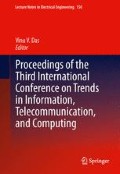Abstract
This study presents a combined operation of the Unified Power Quality Conditioner (UPQC) with Photovoltaic cell system. The proposed system consists of a series inverter, a shunt inverter and a battery connected Photovoltaic array which is connected with the DC link of UPQC through a boost converter. The proposed system compensates the voltage sag, voltage swell, voltage interruption, harmonics, real and reactive power compensation. PV fed UPQC system is simulated in single phase 14-bus and three phase single bus system. The proposed system is validated with the results of computer simulation and hardware implementation. Sag is created by applying heavy load and swell occurs during light load conditions. These power quality problems are compensated with the help of UPQC fed Photovoltaic arrays.
Access this chapter
Tax calculation will be finalised at checkout
Purchases are for personal use only
References
Davari M, Graduate Student Member, IEEE, Ale-Emran SM, Yazdanpanahi H, Gharehpetian GB, Senior Member (2011) IEEE: modeling the combination of UPQC and photovoltaic arrays with multi-input single-output DC–DC converter. IEEE Trans
(1995) IEEE Std 1159: IEEE recommended practice for monitoring eclectic power quality
Fujita H, Akagi H (1998) The unified power quality conditioner: the integration of Series- and shunt-active filters. IEEE Trans Power Electron 13
Kesler M (2010) Synchronous reference frame based application design and analysis of unified power quality conditioner. Ph.D. Dissertation, Kocaeli University of Kocaeli, Turkey
Basu M, Das SP, Dubey GK (2007) Comparative evaluation of two models of UPQC for suitable interface to enhance power quality. Electr Power sys Res 77:821–830
Cavalcanti MC, Azevedo GMS, Amaral BA, Neves FAS (2005) A photovoltaic generation system with unified power quality conditioner function. In: 31st annual conference of IEEE industrial electronics society, 6–10, Brazil, pp. 750–755
Han B, Bae B, Kim H, Baek S (2006) Combined operation of unified power quality conditioner with distributed generation. IEEE Trans Power Del 21:330–338
Kumar GS, Kumar BK, Kumar MM (2010) Optimal VA loading of UPQC during mitigation of unbalanced voltage sags with phase jumps in three-phase four wire distribution system. In: International conference on power system technology, Beijing, China
Khadkikar V, Chandra A (2008) A new control philosophy for a unified power quality conditioner (UPQC) to coordinate load-reactive power demand between shunt and series inverters. IEEE Trans Power Del 23(4):2522–2534
Forghani M, Afsharnia S (2007) Online wavelet transform-based control strategy for UPQC control system. IEEE Trans 22:481–491
Khadkikar V, Chandra A (2011) A novel concept of simultaneous voltage sag/swell and load reactive power compensations utilizing series inverter of UPQC. IEEE Trans Power Electron 26(9)
Lorenzo E (1994) Solar electricity engineering of photovoltaic systems. Internationally recognized expert engineers and scientists of IES Solar Energy Institute
Altas IH, Sharaf AM (2007) A photovoltaic array simulation model for MATLAB-simulink GUI environment. In: International conference on clean electrical power. ICCEP’07, pp 341–345
Esram T, Chapman PL (2007) Comparison of photovoltaic array maximum power point tracking techniques. IEEE Trans Energy Convers 22
Matsuo H, Lin W, Kurokawa F, Shigemizu T, Watanabe N (2004) Characteristics of the multiple- input DC–DC converter. IEEE Trans Ind Electron 51
Noroozian R, Abedi M, Gharehpetian GB, Hosseini SH (2007) On grid and off-grid operation of multi-input single-output DC–DC converter based fuel cell generation system. In: ACEMP’07 and ELECTROMOTION’07 joint meeting, Bodrum, Turkey
Khadkikar V (2012) Enhancing electric power quality using UPQC: a comprehensive overview. IEEE Trans Power Electron 27(5)
Author information
Authors and Affiliations
Corresponding author
Editor information
Editors and Affiliations
Rights and permissions
Copyright information
© 2013 Springer Science+Business Media New York
About this paper
Cite this paper
Balasubramaniyan, S., Sivakumaran, T.S., Thulasidharan, Balamurugan, D. (2013). Improvement of Power Quality and Performance Analysis of PV Fed UPQC in Utility Connected System. In: Das, V. (eds) Proceedings of the Third International Conference on Trends in Information, Telecommunication and Computing. Lecture Notes in Electrical Engineering, vol 150. Springer, New York, NY. https://doi.org/10.1007/978-1-4614-3363-7_34
Download citation
DOI: https://doi.org/10.1007/978-1-4614-3363-7_34
Published:
Publisher Name: Springer, New York, NY
Print ISBN: 978-1-4614-3362-0
Online ISBN: 978-1-4614-3363-7
eBook Packages: EngineeringEngineering (R0)

